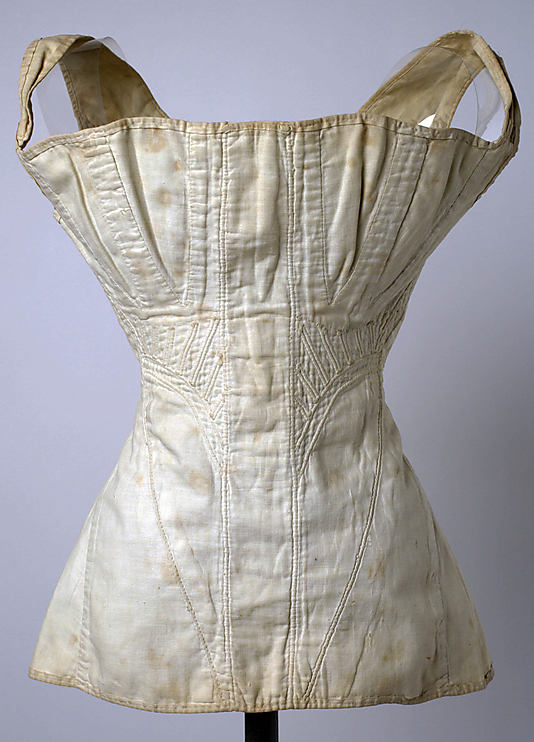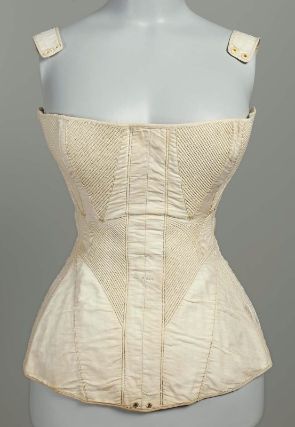Hana-Marmota asked to see 1840s corsets (or stays, as they were still called by all but the most genteel), so here are some I have found. It’s not quite the hundreds I mentioned, but that would make for a very long post!
1840s corsets/stays (see this post for more information on the history of the terms and what to call what when) are probably relatively hard to find in museum collections because the 1840s was a period of transition in styles in corsets. Many corsets that were made or worn in the 1840s are probably identified as earlier, if they follow earlier fashions and techniques, or slightly later, if they use just-introduced cuts and materials.
The style of corsets that would have been on its way out in the 1840s is based on the so-called ‘longline’ corsets of the 1810s and 20s, with a solid front busk, bust gussets, hip gussets or princess seams (well, what we would come to call princess seams) and shoulder straps. The waist suppression for these corsets is fairly minimal, and creates a longer waist. Like their earlier counterparts, these corset rely almost entirely on the busk and cording for support, and have minimal, if any, boning:
They differentiate from the earlier longline corsets of the 1810s/20s in their shaping. The hip gussets are wider, and 1840s corsets have far more emphasis on the waist, and on the bust/waist/hip differential. The classic hourglass shape that would characterise the ideal body shape of the later half of the 19th century is beginning to appear, and the bust-on-a-stick silhouette of Regency fashions is being left behind.
The majority of these style of corsets are made of cotton (primarily white or natural coloured), with cording of various materials, and wooden front busks. Most examples lace up the back with hand-worked lacing holes, though metal grommets, invented in the 1820s, are seen on some examples. Most lace with spiral lacing, but a few examples show even lacing holes, indicating that criss-cross lacing would be used:
The newer, fashion forward and innovative style of corset puts more emphasis on the curved, hourglass figure, with a shorter, nipped in waist, rounder hip gussets, and more shaping achieved through boning, rather than cording. The divided front busk has yet to appear. One of the biggest innovations, beyond the pattern, is the appearance of corsets made in silks and trimmed with lace. This coinciding with the more decorative aspect of undergarments as a whole, as the middle classes grow and the textile revolution makes machine lace and other luxury fabrics to become cheaper and more readily available.
In addition to the two main styles of 1840s corsets, there are a few extent pieces that are sartorial novelties, such as this example, with lacing over the bust:
I would place this on the later end of the Met’s dating spectrum – more 1840s/50s than 1810s, though of course it is impossible to tell without being able to examine it in person. It is a fascinating piece. Is it a nursing corset? If not, what is it?
There are also a few examples of some interesting waist wraps. This first one is most intriguing, as it looks quite professional in its make. Is it a child or mans corset? One for an invalid?
And what about this odd, rather roughly made waist cincher? From the front, it makes perfect sense, but the back view shows that the strap tapers to a very narrow ribbon: Not very helpful for supporting the weight of a skirt!
For more images of 1840s corsets and undergarments, check out my pinterest pages, which are (rather unhelpfully for the purpose of this post) divided into 1820s-40s undergarments, and 1840s-60s undergarments.











Very cool. I imagine those ladies would be absolutely mortified if someone whispered in their ear when they purchased their new corset that one day in the future their underwear would be on display in some of the world’s finest museums.
Or maybe they’d be amused.
That’s the sort of thing I’d do with time travel.
As long as the stains weren’t obviously mine I’d be thrilled to have my intimates on display in a museum!
Interesting how long they are given the rapid change of shape to skirts that stuck out. Or am I getting muddled? Also intersting that cording seems to play a bigger part than boning, busks aside.
Nope, you are right! It is one of those things where the shape of the corset doesn’t seem to match the dress worn over, but I’ll have to make and wear a bunch to really know for sure 😉 I’ve been noticing that about cording too – it’s definitely overlooked as an important component of corsetry.
Thank you very much! I think I’m already familiar with some of them, but not all.
And the more I see of them, the more I’m fascinated by what MrsC said. Maybe it has something to do with the amount of heavy petticoats? That they needed more support for them? (Wild guess. I’m not familar with the practical aspects of corsetry at all.)
P.S. You know, seeing as I want to make that 1848 Czech “national” costume one day, this is a decade I’m really interested in. 🙂 I like those old shapes and corded ones. Somehow, they feel like they would be the right thing to wear under the “national” costume… because the Czech patriots/nationalists of 19th century were apparently not the fashion following crowd.
I wouldn’t actually be hugely surprised if some people in Czechoslovakia were still wearing stays (18th century style) well into the 1840s. From what I’ve read, and from evidence from the time, many people in very rural areas wore very traditional clothes until the late 19th, early 20th century, and it was really only WWI that modernised the more remote areas of Europe. It’s pretty amazing to think how recent that was.
It’s one of those things where I really want to make the whole outfit and wear it to see if I can figure it out!.
This is wonderful! On my wish-list of things to make this year is to complete my 1830s underthings- including revisiting my corset. Very inspiring!